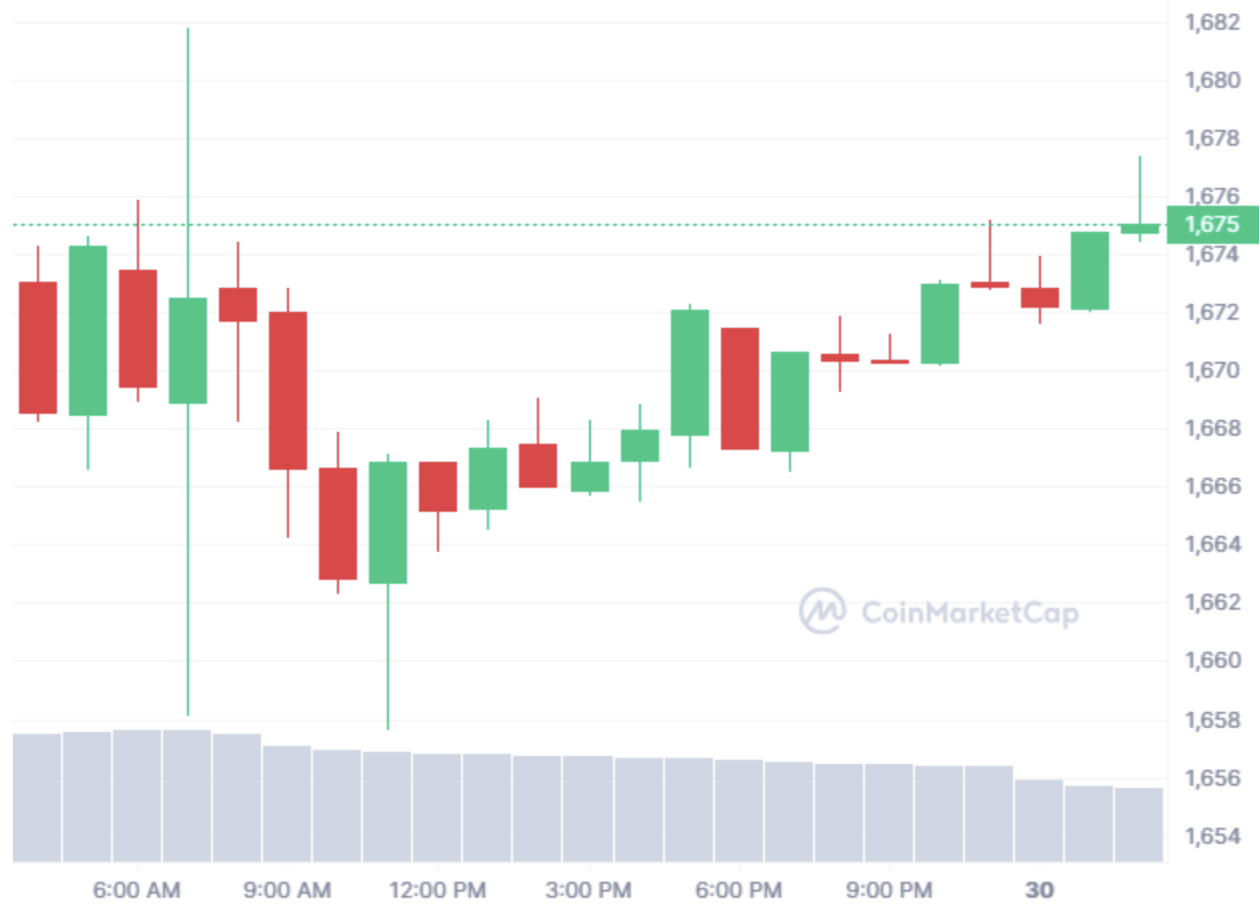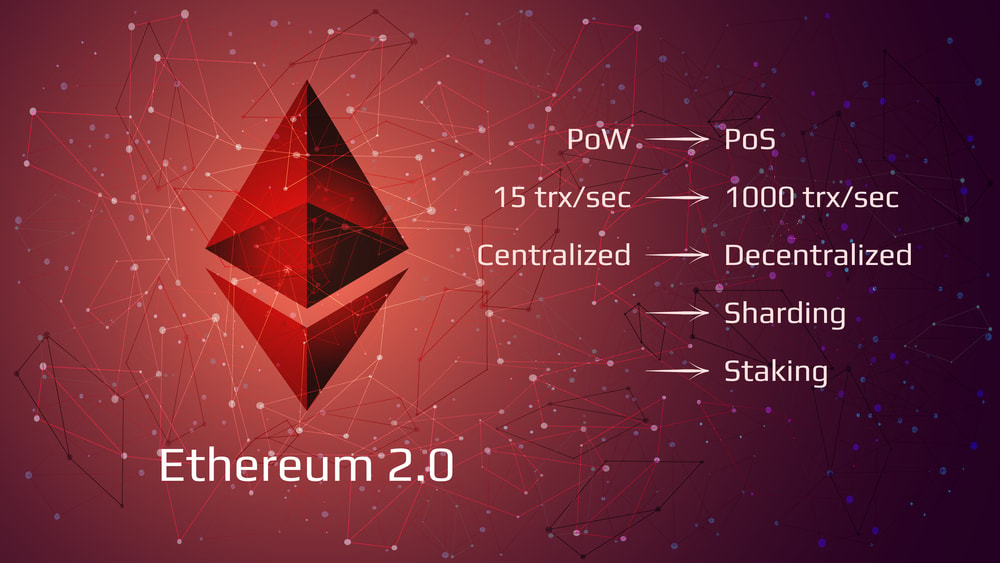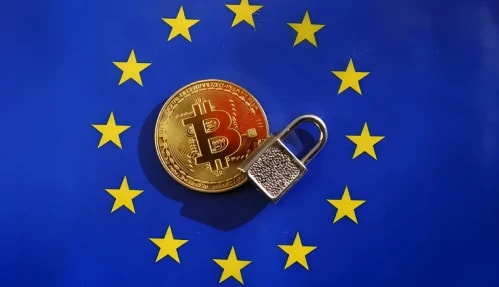Ethereum Price
Ethereum price
Ethereum is one of the most popular and influential cryptocurrencies in the world, second only to Bitcoin in terms of market capitalization and adoption. Ethereum is not just a digital currency, but also a platform for decentralized applications (dApps) that run on smart contracts, which are self-executing agreements that operate on the blockchain. Ethereum has been at the forefront of innovation in the crypto space, introducing new features and upgrades that aim to improve its scalability, security, and efficiency.
One of the most significant changes that Ethereum has undergone is the transition from Proof-of-Work (POW) consensus mechanism to the Proof-of-Stake (POS) consensus mechanism. The switch, also known as the Merge, was completed on September 15, 2022, and marked the end of Ethereum mining as we know it.

A major effect of the Merge is a reduction in new ETH issuance by over 80% - similar to Bitcoin experiencing three consecutive block reward halvings. This phenomenon is referred to as the Ethereum Triple Halving. It results from the combined impacts of staking, burning, and decreased issuance. Staking locks up ETH in validating nodes, lowering circulating supply. Burning destroys a portion of transaction fees, removing it permanently. Issuance declines sharply as validator rewards are much smaller than miner payouts previously, reducing inflation.
Through staking, burning and reduced issuance, the Triple Halving creates scarcity and drives up ETH value over the long term. Unlike Bitcoin's fixed halving schedule, it is an ongoing process influenced by variables like validator count, transaction volume, and network usage. Some analysts foresee Ethereum potentially transitioning to a deflationary model where more ETH is destroyed than created, establishing negative overall supply growth. This could significantly affect both Ethereum's price and its role within the crypto ecosystem.
Ethereum Price Live
The live Ethereum price today (on the day of writing)is $1,675.68 USD with a 24-hour trading volume of $3,846,722,881 USD, according to CoinMarketCap. This represents a slight increase of 0.22% in the past 24 hours. Ethereum is currently ranked as the second-largest cryptocurrency by market cap, with a total value of $201.9 billion USD.
The Ethereum price has been fluctuating in a narrow range between $1,550 and $1,600 for the past week, after experiencing a sharp drop from its all-time high of $4,891.70 USD on May 12th, 2023. The decline was triggered by a series of negative events and sentiments in the crypto market, such as the FTX collapse, regulatory crackdowns, environmental concerns, and profit-taking.
However, Ethereum has also shown some signs of resilience and recovery, as it has outperformed Bitcoin and other major cryptocurrencies in terms of percentage gains since the beginning of 2023. Ethereum has also benefited from the growing popularity and demand for its network and ecosystem, especially in the fields of decentralized finance (DeFi) and non-fungible tokens (NFTs), which are among the hottest trends in the crypto industry.
Ethereum Chart
The Ethereum chart below shows the historical price movements and trends of ETH/USD from August 2015 to September 2023. The chart can be customized to display different time frames, indicators, and tools for technical analysis. You can also use the Ethereum calculator to convert ETH to other currencies or cryptocurrencies.

As you can see from the chart, Ethereum has experienced several cycles of booms and busts since its inception in 2015. The first major rally occurred in 2017, when Ethereum surged from around $10 USD to over $1,400 USD at its peak, driven by the initial coin offering (ICO) craze and the launch of several dApps on its platform. However, this was followed by a prolonged bear market in 2018 and 2019, when Ethereum lost over 90% of its value and traded below $100 USD at its lowest point.
The second major rally happened in 2020 and 2021, when Ethereum soared from around $200 USD to nearly $5,000 USD at its peak, fueled by the rise of DeFi and NFTs, as well as its network upgrades and transition to proof-of-stake (PoS). However, this was also followed by a significant correction in 2022 and 2023, when Ethereum plunged by over 60% from its all-time high and traded below $2,000 USD at its lowest point.
The third major rally is yet to be seen, but many experts and analysts believe that Ethereum has a lot of potential and room for growth in the future, as it continues to innovate and evolve its technology and ecosystem.
Ethereum Price History
Ethereum was launched on July 30th, 2015 by Vitalik Buterin and other co-founders as an open-source platform for smart contracts and dApps. The initial price of ETH was around $0.31 USD during its ICO, which raised over $18 million USD worth of Bitcoin at that time. The first year of Ethereum was relatively stable and modest, as it traded between $0.4 USD and $3 USD for most of 2015 and early 2016.
The first major price spike occurred in March 2016, when Ethereum reached over $10 USD for the first time, following the launch of several dApps such as Augur and MakerDAO on its platform. The second major price spike happened in June 2016, when Ethereum reached over $20 USD for the first time, following the announcement of the DAO project, which was a decentralized autonomous organization that raised over $150 million USD worth of ETH through a crowdfunding campaign.
However, this was also followed by the first major price crash in July 2016, when Ethereum dropped below $10 USD, following the infamous DAO hack, which resulted in the theft of over $50 million USD worth of ETH from the DAO smart contract. This also led to the first hard fork of Ethereum, which split the network into two chains: Ethereum (ETH) and Ethereum Classic (ETC).
The second year of Ethereum was more volatile and explosive, as it traded between $7 USD and $400 USD for most of 2017. The main catalysts for this rally were the ICO boom and the increasing adoption and awareness of Ethereum as a platform for dApps and tokens. The ICO boom was a phenomenon where hundreds of new projects and startups launched their own tokens and raised funds through Ethereum's network, creating a huge demand and hype for ETH. Some of the most notable ICOs that took place on Ethereum in 2017 were EOS, Tezos, Bancor, Status, and Filecoin.
The third year of Ethereum was more bearish and gloomy, as it traded between $80 USD and $1,400 USD for most of 2018. The main factors for this decline were the ICO bust and the regulatory crackdown on cryptocurrencies. The ICO bust was a phenomenon where many of the projects and startups that raised funds through Ethereum's network failed to deliver on their promises, creating a lot of disappointment and distrust among investors and users. The regulatory crackdown was a phenomenon where many governments and authorities around the world imposed stricter rules and regulations on cryptocurrencies, creating a lot of uncertainty and fear among the crypto community.
Fourth year (2019): Ethereum traded between $100 USD and $300 USD for most of 2019. The main events that influenced this period were the launch of several new dApps and platforms on Ethereum, such as Compound, Uniswap, Synthetix, Chainlink, and MakerDAO's DAI stablecoin. These projects introduced new use cases and innovations for Ethereum, such as decentralized lending, trading, derivatives, oracles, and stablecoins.
Fifth year (2020-2021): Ethereum traded between $200 USD and $4,000 USD for most of 2020 and 2021. The main drivers for this surge were the rise of DeFi and NFTs, as well as the anticipation for Ethereum 2.0. DeFi and NFTs were two of the hottest trends in the crypto industry in 2020 and 2021, as they attracted a lot of attention and capital from investors, users, artists, celebrities, and mainstream media. DeFi refers to decentralized financial services that operate on smart contracts without intermediaries, such as lending, borrowing, trading, investing, insurance, and more. NFTs refer to non-fungible tokens that represent unique digital assets that can be verified and owned on the blockchain, such as art, music, games, collectibles, and more.
Sixth year (2022-2023): The sixth year of Ethereum has also been more eventful and transformative, as it witnessed the upgrade to Ethereum 2.0 in September 2022. Ethereum 2.0 was a major milestone for Ethereum, as it marked the end of its transition from a proof-of-work (PoW) consensus mechanism to a proof-of-stake (PoS) consensus mechanism. This also involved the merger of the original Ethereum chain with the beacon chain, which was launched in December 2020 as the first phase of Ethereum 2.0. The merger effectively retired the PoW chain and made the PoS chain the sole and final version of Ethereum.

The upgrade to Ethereum 2.0 has had a significant impact on Ethereum’s price, as it has improved its scalability, security, and efficiency. According to some estimates, Ethereum 2.0 can support up to 100,000 transactions per second (TPS), compared to the previous limit of around 15 TPS on Ethereum 1.0. This means that Ethereum can handle more users and applications without compromising its performance or increasing its fees. Moreover, Ethereum 2.0 has enhanced its security by making it more resistant to attacks and censorship, as well as reducing its energy consumption and environmental impact by switching from PoW to PoS.
Ethereum Price Prediction
Ethereum price prediction is a challenging task due to the unpredictable and volatile nature of the cryptocurrency market. However, based on some factors such as historical trends, technical analysis, fundamental analysis, expert opinions, market sentiment, supply-demand dynamics, network effects, innovation potential, adoption rate, competition, and regulation, we can attempt to make some educated guesses and scenarios for the future price of Ethereum.
According to historical trends, Ethereum has followed a pattern of four-year cycles that coincide with the Bitcoin halving events, which occur every four years and reduce the supply of new Bitcoins by half. The Bitcoin halving events tend to create a ripple effect on the entire crypto market, as they increase the scarcity and demand for Bitcoin, which in turn boosts its price and value. This also creates a positive feedback loop for other cryptocurrencies, especially Ethereum, which is closely correlated with Bitcoin.
The first cycle of Ethereum lasted from 2015 to 2019, when it reached its first peak in January 2018, followed by a deep trough in December 2018. The second cycle of Ethereum lasted from 2019 to 2023, when it reached its second peak in May 2023, followed by a sharp correction in June 2023. The third cycle of Ethereum is expected to last from 2023 to 2027, when it could potentially reach its third peak in 2025 or 2026, followed by another correction in 2027 or 2028.
Based on this pattern, some analysts predict that Ethereum could reach new highs of $10,000 USD , $20,000 USD , or even $100,000 USD by the end of the third cycle. However, these predictions are based on extrapolating the past performance and assuming that the same factors and conditions will continue to apply in the future, which may not be the case.
According to technical analysis, Ethereum has been trading in a descending triangle pattern since May 2023, which is a bearish continuation pattern that indicates a downward breakout. The triangle has a horizontal support line at around $1,500 USD and a descending resistance line that connects the lower highs of Ethereum. The triangle is expected to break out by October or November 2023, which could result in a significant price movement in either direction.
If Ethereum breaks below the support line, it could trigger a sell-off that could push its price down to $1,000 USD or lower. However, if Ethereum breaks above the resistance line, it could signal a reversal that could push its price up to $2,500 USD or higher. The breakout direction will depend on several factors such as the volume, momentum, news, and sentiment of the market.
According to fundamental analysis, Ethereum has a strong value proposition and competitive advantage over other cryptocurrencies due to its network effects and innovation potential. Ethereum has the largest and most active developer community in the crypto space , which constantly works on improving and upgrading its technology and ecosystem. Ethereum also has the most diverse and vibrant user base in the crypto space , which includes investors, traders, developers, entrepreneurs, artists, gamers, collectors, and more. Ethereum also has the most extensive and robust ecosystem in the crypto space , which consists of thousands of dApps and platforms that offer various services and solutions for different sectors and industries.
According to market sentiment, Ethereum has a mixed and balanced sentiment among the crypto community and the general public. On one hand, Ethereum has a lot of supporters and fans who believe in its vision and mission, and who are loyal and passionate about its network and ecosystem. On the other hand, Ethereum also has a lot of critics and skeptics who doubt its viability and feasibility, and who are hostile and negative about its network and ecosystem.
The sentiment of Ethereum can be measured by various indicators such as social media activity , Google trends , media coverage , surveys , and more. These indicators show that Ethereum has a moderate level of interest, awareness, and engagement among the crypto community and the general public, which could change depending on the news, events, and developments that affect Ethereum.
What is Ethereum?

What is the difference between Ethereum and Bitcoin?

How can I buy Ethereum?

How can I store Ethereum?










